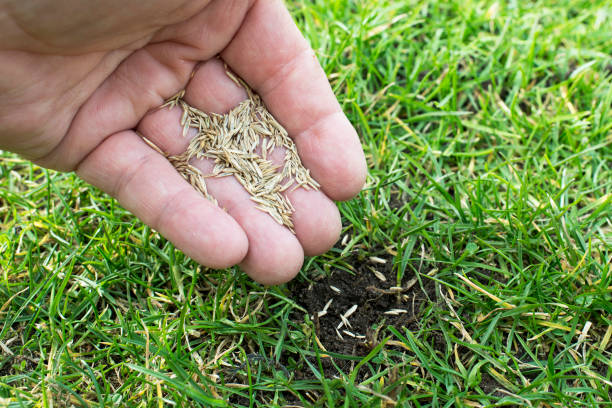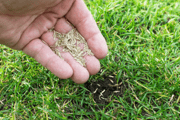
Spring has arrived across Australia, and with it comes longer daylight hours, warmer weather, and the irresistible urge to spend more time outdoors with our four-legged companions.
But hidden amongst the lush grass in our parks, bushlands, and even suburban streets lies a threat so subtle that many dog owners don't realise their pet is in danger until it's too late.
Grass seeds might look harmless, but for dogs, they're anything but. These tiny, barbed invaders have earned themselves the nickname 'nature's fishhooks' amongst veterinarians, and with good reason.
In one recent study from south west rural NSW, 2 per cent of the dogs seen at veterinary clinics during spring and summer came in because of grass seeds. Medical issues ranged from mild swelling to life-threatening illness.
'They push along every time a dog moves... They can move a fair way into the body... I've seen one before in a dog's chest cavity'
In this article
When a simple walk turns into a $2,000 nightmare
Ask Sydney dog owner Adam about grass seeds, and he'll tell you about the day his beloved cocker spaniel Russell developed what looked like a harmless lump on his head. What started as a routine vet visit for suspected tumour removal turned into a $2,000 lesson about the hidden dangers of Australian parks.
'He had a lump on his head, the vet did tests on it and said to have it removed in case it was a tumour. It was a grass seed,' Adam told Yahoo News. Thankfully, his pet insurance covered most of the bill, leaving him with just a $300 out-of-pocket expense—but not all pet owners are so fortunate.
24 per cent of Australians have had a vet bill of up to $5,000, and grass seed removal can easily fall into this category when complications arise. Surgery for a foreign object ingestion averages $5,000 but can reach $41,000 in complex cases, while cancer or tumour treatments average $2,000—$4,000.
Australia's grass seed season
The grasses that cause problems flower from October to December, mainly in response to rain. So, more dogs are seen with grass seed issues following lots of rain in spring and summer.
Peak danger period varies by region, but generally runs from October through to February across most of Australia.
The science behind the threat
What makes grass seeds particularly insidious is their evolutionary design. Awns are stiff, sharp bristles that grow from grasses such as spear grass, barley grass, wild oats, brome grass and cereals (including rye, wheat and barley).
They are equipped with many small barbs pointing backwards, which enable the awns to attach themselves to a dog's fur and which only allow movement in one direction—inwards, towards the animal's body.
Having anchored themselves to the coat, the awns work their way deeper into the fur every time the dog moves. With their sharp tips, awns are able to puncture the animal's skin and become lodged there, where they can cause infections, inflammation and abscesses.
Dr Heather Burton, speaking to Yahoo News, explained why these seeds pose such a 'silent' threat: 'The skin can close over [and] now you've got something foreign under the skin that can introduce dirt and bacteria, and infections can occur.'
Where danger lurks
The most common entry points for grass seeds are areas where your dog's fur is thinner or where natural openings occur.
The study from rural NSW actually found that 47 per cent of dogs with grass seeds coming to see a general vet, actually had the grass seed stuck in their ear.
Paws are another hotspot, particularly between the toes where dogs are most likely to lick and chew, potentially driving the seed deeper.
But it's not just ears and paws dog owners need to worry about. Grass seeds frequently get snorted up the nose or inhaled down the windpipe. Once inside the body, the seeds migrate.
The seeds will take the path of least resistance. For example, grass seeds that are inhaled go down to the lungs. There they cause pneumonia.
From the lungs, the grass seeds tend to travel into the chest space (outside the lungs), then follow the diaphragm (the muscle between the chest and the abdomen) towards the spine, and travel up into the spinal cord.
Who's most at risk?
While all dogs can fall victim to grass seeds, some are more vulnerable than others. The original Charles Sturt University study mentioned in Adam's case found that medium-length-haired dogs were three times more likely to be affected, suggesting their dense undercoats provide the perfect catching mechanism for these botanical hitchhikers.
In Dr. Blake's case, most of the dogs she saw during that busy month were 'off-leash during hikes.' Working dogs, hunting dogs, and those who love to explore off the beaten track face higher risks simply due to increased exposure.
Warning signs to watch for
- Sudden, persistent head shaking or ear scratching
- Excessive licking or chewing at paws
- Unexplained swelling, particularly between toes
- Persistent sneezing after outdoor activity
- Discharge from eyes, nose, or ears
- Lameness or limping
- Any unusual lump or bump that appears after outdoor time
Prevention is better than expensive cures
The good news is that preventing grass seed injuries doesn't require keeping your dog indoors for months. A few simple strategies can dramatically reduce the risk:
Post-walk inspection routine: Grooming your pets carefully, especially after they have been around areas that may have foxtails. Check between their toes, as well as in their ears, armpits, and groin areas.
Strategic grooming: Keeping the hair between the toes, ears, and belly trimmed, especially for longhaired dogs. Foxtails can easily attach to long hair.
Smart walking choices: Foxtails are commonly found in tall grasses that are off the main walkways or hiking paths. Avoid letting your dog run through open fields of tall grass during the foxtail season, typically late spring, summer, and early fall.
Protective gear: For dogs who need extra protection—particularly working or hunting dogs—consider protective booties and even specialised face guards designed to prevent inhalation of grass seeds.
The cost of waiting
Dr Burton's advice is clear: early intervention is key. 'I always recommend brushing when you come home from the park or a walk. It's good to do this time of the year, too, because you're reducing the pollen load coming into your house.'
Early diagnosis and removal is ideal. The deeper a foxtail migrates into the body, the more likely surgery will be required to find and remove it. What might be a simple removal procedure in the early stages can quickly escalate to complex surgery if the seed migrates deeper into the body.
With dog owners spending an annual average of $631 on veterinary services, and fewer than 10 per cent of pets insured, an unexpected grass seed emergency can create significant financial stress for families.
Did you know?
Did you know?
Amongst the Australian veterinary community, spring and summer are known as grass-seed season. During these seasons especially prevalent in rural and regional Australia, more dogs had to seek medical treatment caused by grass seeds. Some veterinary practices report seeing multiple grass seed cases daily during peak season.
Regional variations across Australia
While grass seeds are a concern nationwide, some areas pose higher risks than others. The grasses that cause problems flower from October to December, mainly in response to rain. So, more dogs are seen with grass seed issues following lots of rain in spring and summer.
Rural and regional areas tend to see higher rates of grass seed problems, but urban dog owners shouldn't feel complacent. Parks, nature strips, and even neglected suburban blocks can harbour dangerous grass varieties.
When to seek immediate help
Taking your dog to the veterinarian as soon as possible if you notice head shaking or persistent sneezing after being in an area with foxtails. These are common signs of foxtails in the nose and ears. In general, foxtail retrieval is easier the sooner it is identified.
Don't attempt to remove grass seeds yourself if they're embedded deeply or located in sensitive areas like ears, eyes, or nose. It is extremely important that if a grass seed is suspected, that a visit to your veterinarian happens as soon as possible.
In most scenarios, they will need to place your dog under sedation or general anaesthesia to examine, clean and no doubt explore the area to find the grass seed.
What This Means For You
The message for Australian dog owners is clear: awareness and prevention are your best defence against these tiny but potentially devastating invaders. A few minutes of post-walk grooming and inspection can save you thousands of dollars and, more importantly, spare your beloved companion unnecessary pain and suffering.
As we head into the warmer months, keep grass seeds on your radar. Your dog's health—and your wallet—will thank you for it.
Have you had experience with grass seeds affecting your pet? We'd love to hear your prevention tips and stories in the comments below—your experience could help fellow dog owners keep their companions safe.
Original Article
https://au.news.yahoo.com/warning-a...ssie-parks-cost-dog-owner-2000-062455989.html
Protecting Dogs from Grass Seeds & Foxtails | Australian Dog Lover
Cited text: In one recent study from south west rural NSW, 2 per cent of the dogs seen at veterinary clinics during spring and summer came in because of grass seeds. Medi...
Excerpt: In one recent study from south west rural NSW, 2 per cent of the dogs seen at veterinary clinics during spring and summer came in because of grass seeds.
https://www.australiandoglover.com/2020/11/protecting-dogs-from-grass-seeds.html
14 Interesting Australian Veterinary Statistics to Know in 2025 | PangoVet
Cited text: 24 per cent of Australians have had a vet bill of up to $5,000.
Excerpt: 24 per cent of Australians have had a vet bill of up to $5,000
https://resources.pangovet.com/statistics/veterinarian-statistics-australia/
How much does it cost to see a vet in 2025? | Choosi
Cited text: According to PetSure’s Pet Health Monitor, here are a few examples of how emergency or specialty procedures can vary: Surgery for a foreign object ing...
Excerpt: Surgery for a foreign object ingestion averages $5,000 but can reach $41,000 in complex cases, while cancer or tumour treatments average $2,000—$4,000.
https://www.choosi.com.au/pet-insurance/articles/cost-of-vet-visit-2025
Protecting Dogs from Grass Seeds & Foxtails | Australian Dog Lover
Cited text: The grasses that cause problems flower from October to December, mainly in response to rain. So, more dogs are seen with grass seed issues following l...
Excerpt: The grasses that cause problems flower from October to December, mainly in response to rain.
https://www.australiandoglover.com/2020/11/protecting-dogs-from-grass-seeds.html
Awns / Grass Seeds: Why They Pose a Danger to Dogs—FOUR PAWS in Australia—Animal Welfare Organisation
Cited text: Awns are stiff, sharp bristles that grow from grasses such as spear grass, barley grass, wild oats, brome grass and cereals (including rye, wheat and ...
Excerpt: Awns are stiff, sharp bristles that grow from grasses such as spear grass, barley grass, wild oats, brome grass and cereals (including rye, wheat and barley).
https://www.four-paws.org.au/our-st...ns-grass-seeds-why-they-pose-a-danger-to-dogs
Awns / Grass Seeds: Why They Pose a Danger to Dogs—FOUR PAWS in Australia—Animal Welfare Organisation
Cited text: Having anchored themselves to the coat, the awns work their way deeper into the fur every time the dog moves. Medical problems caused by grass seeds i...
Excerpt: Having anchored themselves to the coat, the awns work their way deeper into the fur every time the dog moves.
https://www.four-paws.org.au/our-st...ns-grass-seeds-why-they-pose-a-danger-to-dogs
Protecting Dogs from Grass Seeds & Foxtails | Australian Dog Lover
Cited text: The study from rural NSW actually found that 47 per cent of dogs with grass seeds coming to see a general vet, actually had the grass seed stuck in their ear.
Excerpt: The study from rural NSW actually found that 47 per cent of dogs with grass seeds coming to see a general vet, actually had the grass seed stuck in their ear.
https://www.australiandoglover.com/2020/11/protecting-dogs-from-grass-seeds.html
Protecting Dogs from Grass Seeds & Foxtails | Australian Dog Lover
Cited text: Grass seeds frequently get snorted up the nose or inhaled down the windpipe. Once inside the body, the seeds migrate. The seeds will take the path of ...
Excerpt: Grass seeds frequently get snorted up the nose or inhaled down the windpipe. Once inside the body, the seeds migrate.
https://www.australiandoglover.com/2020/11/protecting-dogs-from-grass-seeds.html
Trail Tips: The Dangers of Foxtails for Your Dog & How to Protect Them—Wilderdog
Cited text: In Dr. Blake’s case, most of the dogs she saw during that busy month were “off-leash during hikes.” That’s why it's always a good idea to take a look ...
Excerpt: Blake's case, most of the dogs she saw during that busy month were 'off-leash during hikes.'
https://www.wilderdog.com/blogs/wee...-of-foxtails-for-your-dog-how-to-protect-them
Foxtails and Dogs | Animal Health Topics / School of Veterinary Medicine
Cited text: Grooming your pets carefully, especially after they have been around areas that may have foxtails. Check between their toes, as well as in their ears,...
Excerpt: Grooming your pets carefully, especially after they have been around areas that may have foxtails.
https://healthtopics.vetmed.ucdavis.edu/health-topics/foxtails
Foxtails and Dogs | Animal Health Topics / School of Veterinary Medicine
Cited text: Keeping the hair between the toes, ears, and belly trimmed, especially for longhaired dogs. Foxtails can easily attach to long hair.
Excerpt: Keeping the hair between the toes, ears, and belly trimmed, especially for longhaired dogs.
https://healthtopics.vetmed.ucdavis.edu/health-topics/foxtails
Foxtail Injuries in Dogs: What to Do | Preventive Vet
Cited text: Foxtails are commonly found in tall grasses that are off the main walkways or hiking paths. Avoid letting your dog run through open fields of tall gra...
Excerpt: Foxtails are commonly found in tall grasses that are off the main walkways or hiking paths.
https://www.preventivevet.com/dogs/preventing-and-treating-foxtail-injuries-to-dogs
Foxtails and Dogs | Animal Health Topics / School of Veterinary Medicine
Cited text: Early diagnosis and removal is ideal. The deeper a foxtail migrates into the body, the more likely surgery will be required to find and remove it.
Excerpt: Early diagnosis and removal is ideal. The deeper a foxtail migrates into the body, the more likely surgery will be required to find and remove it.
https://healthtopics.vetmed.ucdavis.edu/health-topics/foxtails
14 Interesting Australian Veterinary Statistics to Know in 2025 | PangoVet
Cited text: Dog owners spend an annual average of $631 on veterinary services, while cat owners spend $388.
Excerpt: dog owners spending an annual average of $631 on veterinary services
https://resources.pangovet.com/statistics/veterinarian-statistics-australia/
14 Australia Pet Industry Statistics to Know in 2025: Trends, Market Size & FAQ—Dogster
Cited text: Fewer than 10 per cent of pets are insured.
Excerpt: fewer than 10 per cent of pets insured
https://www.dogster.com/statistics/pet-industry-statistics-australia
Awns / Grass Seeds: Why They Pose a Danger to Dogs—FOUR PAWS in Australia—Animal Welfare Organisation
Cited text: Amongst the Australian veterinary community, spring and summer are known as grass-seed season. During these seasons especially prevalent in rural and ...
Excerpt: Amongst the Australian veterinary community, spring and summer are known as grass-seed season.
https://www.four-paws.org.au/our-st...ns-grass-seeds-why-they-pose-a-danger-to-dogs
Foxtails and Dogs | Animal Health Topics / School of Veterinary Medicine
Cited text: Taking your dog to the veterinarian as soon as possible if you notice head shaking or persistent sneezing after being in an area with foxtails. These ...
Excerpt: Taking your dog to the veterinarian as soon as possible if you notice head shaking or persistent sneezing after being in an area with foxtails.
https://healthtopics.vetmed.ucdavis.edu/health-topics/foxtails
Grass Seeds in Pets | Signs, Risks & Treatment Tips
Cited text: It is extremely important that if a grass seed is suspected, that a visit to your veterinarian happens as soon as possible. In most scenarios, they wi...
Excerpt: It is extremely important that if a grass seed is suspected, that a visit to your veterinarian happens as soon as possible.
https://berwickvet.com.au/grass-see...t-a-very-big-problem-in-a-very-small-package/







